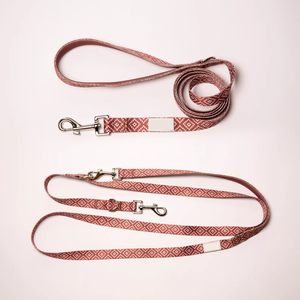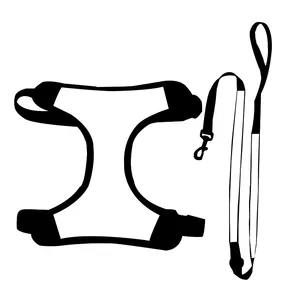(13049 products available)




















































































































































































OEM dog harnesses come in various types, each designed to meet specific needs and preferences. Here are some popular types:
Standard Harness
The standard harness is made of straps that form a shape similar to an H. The design is simple and easy to wear. It is suitable for daily walks and offers good control over the dog. It distributes the pressure across the dog’s body, making it a comfortable option for both small and large breeds.
Vest Harness
This type of harness fits like a vest, covering a larger area of the dog’s body. It provides more support and is ideal for dogs that pull on their leashes. The vest harness has padded sections that make it comfortable for long walks or training sessions.
Back-Clip Harness
As the name suggests, the clip for the leash is attached at the back of the harness. This type is great for small dogs and those that do not pull much on the leash. It allows for easy wearing and removal but may not be suitable for training, as it encourages pulling.
Front-Clip Harness
The front-clip harness has the leash attachment at the front, near the dog’s chest. This gives the owner more control over the dog and is ideal for training. It helps to stop pulling since the dog turns towards the owner when it pulls on the leash.
Adjustable Harness
The adjustable harness has straps that can be changed in size to fit different body shapes. It is suitable for growing puppies since it can be made larger as they grow. It is also good for dogs with weight changes.
Step-In Harness
The step-in harness is worn by making the dog step into it with both front legs. After that, the owner secures the top part on its back. This type is easy and quick to put on. It is comfortable and prevents slipping out because it fits well.
OEM dog harness designs vary by brand but generally prioritize comfort, safety, and functionality. They often include padded straps, adjustable points for a custom fit, and clips for easy on/off. Materials used are typically durable fabrics like nylon or polyester, chosen for their strength and ease of cleaning. Some harnesses feature reflective elements for nighttime visibility and harnesses with built-in leash attachments, which add convenience for daily walks. The color palette ranges from classic neutrals to vibrant hues, allowing for brand and market-specific customization.
Parts
Straps
Connectors
Body
Adjusters
Padding
Materials
Color Options
Parts
Structure
Safety Features
Manufacturing Aspects
The harness must be flawless and functional in design to ensure durable usage. The materials utilized for the harness are typically strong and solid, such as nylon or polyester. In addition to guaranteeing the harness's durability, these materials are also easy to clean and maintain. The manufacturing aspect of the dog harness involves several steps, such as:
Quality Control
Testing
Assembly
Each part of the harness is combined to form the complete product. This includes attaching all straps, connectors, and pieces to the body.
Sewing
Cutting
Designing
Making a Prototype
Material Selection
Materials for the harness are selected based on the type of design and for how long the harness will be used. For instance, a more comfortable material will be preferred for a design used for long walks.
Training and Obedience:
Dog harnesses are useful during obedience training. It gives the trainer control over the dog. The harness is more comfortable for the dog than a collar, especially when teaching. It spreads pressure evenly across the dog. This makes it less likely to harm the dog's neck. Trainers use harnesses to teach loose-leash walking. The design prevents pulling. Some harnesses even have special features to discourage pulling.
Daily Walks:
OEM dog harnesses make daily walks safe and enjoyable. They give the owner good control, making it easy to guide the dog. This helps prevent the dog from escaping or injuring itself. Harnesses are comfy for long wear. They evenly distribute pressure across the dog's body. This makes them suitable for all types of dogs, including those with neck issues.
Adventure and Travel:
For active dogs who enjoy adventures, a harness is a must. It helps when hiking, running, or biking. An OEM dog harness provides reliable control in the wild. It stops the dog from getting lost. Harnesses often have attachment points for leashes, which are useful for climbing or exploring. Some travel harnesses also double as seatbelt restraints for cars, keeping pets safe during journeys.
Medical Needs:
Dog harnesses are also suitable for dogs with special medical needs. They work well for dogs with arthritis or other mobility issues. They help these dogs move with less strain on their muscles and joints. They are also helpful for senior dogs who may need extra support during walks. Harnesses can help lift these dogs. They are also useful for recovering dogs after surgery.
Service and Therapy Dogs:
Service dogs assisting people with disabilities wear special harnesses. These harnesses may have attachments for carrying equipment or for performing tasks. Therapy dogs also use harnesses during visits to hospitals or schools. These harnesses often have identifying patches to show the dog’s purpose.
Weather Protection:
OEM dog harnesses can protect dogs from extreme weather. In cold weather, harnesses can be fitted with features like extra insulation or protection for the chest and belly. This is suitable for breeds that are susceptible to the cold. In hot weather, some harnesses have cooling features. This helps dogs stay comfortable in warm temperatures.
Enhanced Safety:
Harnesses are safer than collars for many applications. For example, a harness can prevent a dog from escaping more effectively during walks or hikes. It distributes pressure more safely, reducing the risk of injury. Harnesses also have safety features like reflective materials for nighttime visibility and lights or attachments for carrying emergency gear.
Size and Breed:
Choosing the right harness for a dog starts with considering its size and breed. Smaller breeds like Chihuahuas require harnesses that distribute pressure gently due to their delicate necks. Larger breeds, on the other hand, need harnesses that can handle their strength and offer secure control. Medium-sized dogs benefit from a balance of comfort and control. It's important to select a harness that fits well, allowing for two fingers' space between the dog and wearer.
Purpose and Activity Level:
Next, the dog's purpose and activity level should be assessed. High-energy dogs benefit from harnesses with extra security for long walks or runs. Service and assistance dogs require harnesses with handles for tasks. Casual walkers can opt for comfortable designs. This ensures the harness suits its intended use and keeps the dog comfortable during activities.
Fit and Adjustability:
Fit and adjustability are also important. A good harness should fit snugly but not too tightly, with adjustable straps to customize the fit for different body shapes. It's advised to measure the dog's chest and neck before purchasing a harness. This allows for selecting one that won't chafe or allow the dog to escape, enhancing safety and comfort.
Material and Durability:
The material and durability of the harness should be considered. Opt for lightweight, breathable materials like nylon or mesh, especially for hot weather. These materials provide comfort and are often water-resistant. For dogs that enjoy swimming or playing in water, this is a good feature. Additionally, choose harnesses with sturdy stitching and clips that can withstand the dog's energy levels.
Features:
Lastly, consider any special features. Some harnesses have padded straps for extra comfort during long walks. Reflective elements enhance visibility during nighttime outings, which is very important for safety. Leash attachments at the front and back offer different control options, useful for training or casual walks. Select a harness with features that meet both the dog's and owner's needs.
Q1: What are the benefits of an OEM dog harness?
A1: OEM harnesses provide a unique branding opportunity and the flexibility to design a product that meets specific needs.
Q2: What is the difference between a dog harness and a dog collar?
A2: A harness fits around a dog's body and distributes pulling force more evenly, while a collar is worn around the neck primarily for holding identification tags and leashes.
Q3: Which type of harness is ideal for small dogs?
A3: Front-clip harnesses are great for small dogs because they offer better control and prevent choking by pulling on the front.
Q4: How can one ensure a comfortable fit with a dog harness?
A4: Measure the dog's size accurately and adjust all straps to achieve a snug but not tight fit, thereby eliminating any uncomfortable rubbing or chafing.
Q5: What features should be considered when selecting a durable dog harness?
A5: Look for sturdy materials, reinforced stitching, and high-quality clips and buckles that can withstand wear from frequent use or energetic dogs.